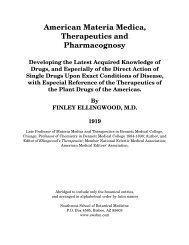SCARLET FEVER. Synonyms.—Scarlatina; Scarlet Rash. Definition ...
SCARLET FEVER. Synonyms.—Scarlatina; Scarlet Rash. Definition ...
SCARLET FEVER. Synonyms.—Scarlatina; Scarlet Rash. Definition ...
Create successful ePaper yourself
Turn your PDF publications into a flip-book with our unique Google optimized e-Paper software.
“With Predominant Affection of the Gastro-Enteric Mucous<br />
Membranes.—In some cases we observe, at the commencement, marked<br />
symptoms of disorder of the stomach; the tongue is heavily coated,<br />
especially at its base, with a dirty-yellowish secretion; there is slight<br />
nausea; disgust for food, and oppression in the epigastrium; everything<br />
that is administered is taken by the patient with difficulty, and<br />
frequently ejected. This condition is not generally accompanied with as<br />
high febrile reaction as in the uncomplicated fever; but there is rapid<br />
prostration, and manifestation of typhoid symptoms. In this case there is<br />
increased secretion of mucus from the mucous membrane of the<br />
stomach, which, if allowed to remain, will undergo decomposition, and,<br />
being slowly absorbed, will generate decomposition of the blood. In other<br />
cases there is marked irritation of the stomach, manifested by redness of<br />
the tip and edges of the tongue, uneasiness in, and pain on pressure<br />
over, the epigastrium, with nausea and rejection of fluids and solids<br />
taken into the stomach. In this case, all the febrile symptoms are<br />
increased.<br />
“The enteric affection does not generally manifest itself in the early<br />
stage of the 'disease. It commences with looseness of the bowels, two,<br />
three, or four evacuations in the twenty-four hours, with pain and<br />
soreness in the abdomen, especially on pressure. The tongue is moist<br />
and loaded with a dirty-white or grayish fur, which, as the fever<br />
advances, changes to brown, and sordes appear on the teeth and lips; in<br />
some cases, the edges and tip of the tongue are reddened. In this case,<br />
the fever rapidly assumes a typhoid character.”<br />
Diagnosis.—The diagnosis of febricula is not difficult if we remember<br />
its chief characteristics; namely, the sudden onset, high temperature,<br />
104° or 105° within twenty-four hours, and great restlessness and<br />
undue complaint, notwithstanding the tongue is comparatively clean<br />
and moist, and the absence of hardness of pulse, although very rapid,<br />
and the early decline of all of the above seemingly grave symptoms,<br />
render the case quite plain.<br />
In synochal fever, the continued reaction determines the type of the<br />
fever; the great excitation of the nervous system, with but little<br />
prostration, and the full, bounding pulse, distinguish it from synochoid<br />
or typhoid.<br />
In synochoid, the history of a slow forming stage, the uniform<br />
The Eclectic Practice of Medicine - PART I - Infectious Diseases - Page 259

















